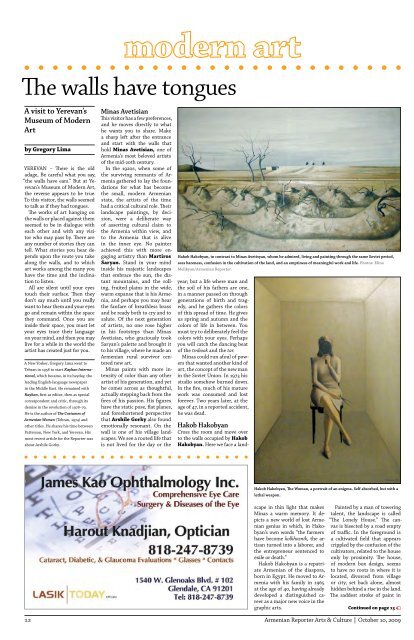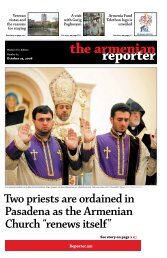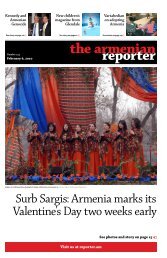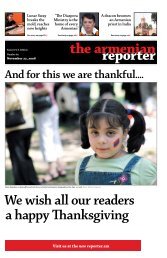Western U.S. edition - Armenian Reporter
Western U.S. edition - Armenian Reporter
Western U.S. edition - Armenian Reporter
You also want an ePaper? Increase the reach of your titles
YUMPU automatically turns print PDFs into web optimized ePapers that Google loves.
The walls have tonguesA visit to Yerevan’sMuseum of ModernArtby Gregory LimaYEREVAN – There is the oldadage, Be careful what you say,“the walls have ears.” But at Yerevan’sMuseum of Modern Art,the reverse appears to be true.To this visitor, the walls seemedto talk as if they had tongues.The works of art hanging onthe walls or placed against themseemed to be in dialogue witheach other and with any visitorwho may pass by. There areany number of stories they cantell. What stories you hear dependsupon the route you takealong the walls, and to whichart works among the many youhave the time and the inclinationto listen.All are silent until your eyestouch their surface. Then theydon’t say much until you reallywant to hear them and your eyesgo and remain within the spacethey command. Once you areinside their space, you must letyour eyes trace their languageon your mind, and then you maylive for a while in the world theartist has created just for you.A New Yorker, Gregory Lima went toTehran in 1958 to start Kayhan International,which became, in its heyday, theleading English- language news paperin the Middle East. He remained withKayhan, first as editor, then as specialcorrespondent and critic, through itsdemise in the revolution of 1978–79.He is the author of The Costumes of<strong>Armenian</strong> Women (Tehran, 1974) andother titles. He shares his time betweenPatterson, New York, and Yerevan. Hismost recent article for the <strong>Reporter</strong> wasabout Arshile Gorky.Minas AvetisianThis visitor has a few preferences,and he moves directly to whathe wants you to share. Makea sharp left after the entranceand start with the walls thathold Minas Avetisian, one ofArmenia’s most beloved artistsof the mid-20th century.In the 1920s, when some ofthe surviving remnants of Armeniagathered to lay the foundationsfor what has becomethe small, modern <strong>Armenian</strong>state, the artists of the timehad a critical cultural role. Theirlandscape paintings, by decision,were a deliberate wayof asserting cultural claim tothe Armenia within view, andto the Armenia that is alivein the inner eye. No painterachieved this with more engagingartistry than MartirosSaryan. Stand in your mindinside his majestic landscapesthat embrace the sun, the distantmountains, and the rolling,fruited plains in the wide,warm expanse that is his Armenia,and perhaps you may hearthe fanfare of breathless brassand be ready both to cry and tosalute. Of the next generationof artists, no one rose higherin his footsteps than MinasAvetisian, who graciously tookSaryan’s palette and brought itto his village, where he made an<strong>Armenian</strong> rural survivor centerednew art.Minas paints with more intensityof color than any otherartist of his generation, and yethe comes across as thoughtful,actually stepping back from thefires of his passion. His figureshave the static pose, flat planes,and foreshortened perspectivethat Arshile Gorky also foundemotionally resonant. On thewall is one of his village landscapes.We see a rooted life thatis not lived for the day or theHakob Hakobyan, in contrast to Minas Avetisyan, whom he admired, living and painting through the same Soviet period,sees bareness, confusion in the cultivation of the land, and an emptiness of meaningful work and life. Photos: ElinaMelikyan/<strong>Armenian</strong> <strong>Reporter</strong>.year; but a life where man andthe soil of his fathers are one,in a manner passed on throughgenerations of birth and tragedy,and he gathers the colorsof this spread of time. He givesus spring and autumn and thecolors of life in between. Youmust try to deliberately feel thecolors with your eyes. Perhapsyou will catch the dancing beatof the tmbook and the tar.Minas could run afoul of powersthat wanted another kind ofart, the concept of the new manin the Soviet Union. In 1973 hisstudio somehow burned down.In the fire, much of his maturework was consumed and lostforever. Two years later, at theage of 47, in a reported accident,he was dead.Hakob Hakobyan, The Woman, a portrait of an enigma. Self absorbed, but with alethal weapon.Hakob HakobyanCross the room and move overto the walls occupied by HakobHakobyan. Here we face a landscapein thin light that makesMinas a warm memory. It depictsa new world of lost <strong>Armenian</strong>genius in which, in Hakobyan’sown words “the farmershave become kolkhoznik, the artisanturned into a laborer, andthe entrepreneur sentenced toexile or death.”Hakob Hakobyan is a repatriate<strong>Armenian</strong> of the diaspora,born in Egypt. He moved to Armeniawith his family in 1965at the age of 40, having alreadydeveloped a distinguished careeras a major new voice in thegraphic arts.Painted by a man of toweringtalent, the landscape is called“The Lonely House.” The canvasis bisected by a road emptyof traffic. In the foreground isa cultivated field that appearscrippled by the confusion of thecultivators, related to the houseonly by proximity. The house,of modern box design, seemsto have no roots in where it islocated, divorced from villageor city, set back alone, almosthidden behind a rise in the land.The saddest stroke of paint inContinued on page 13 12 <strong>Armenian</strong> <strong>Reporter</strong> Arts & Culture | October 10, 2009
















